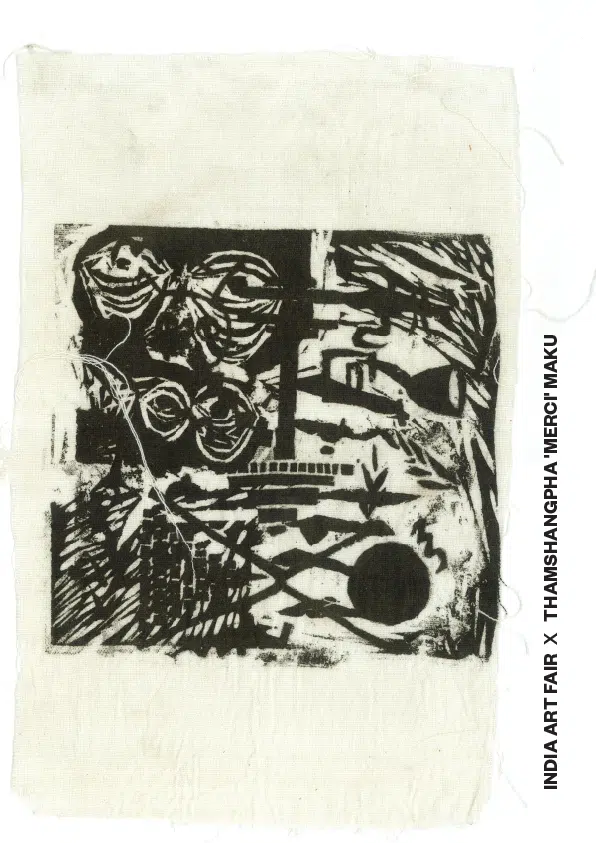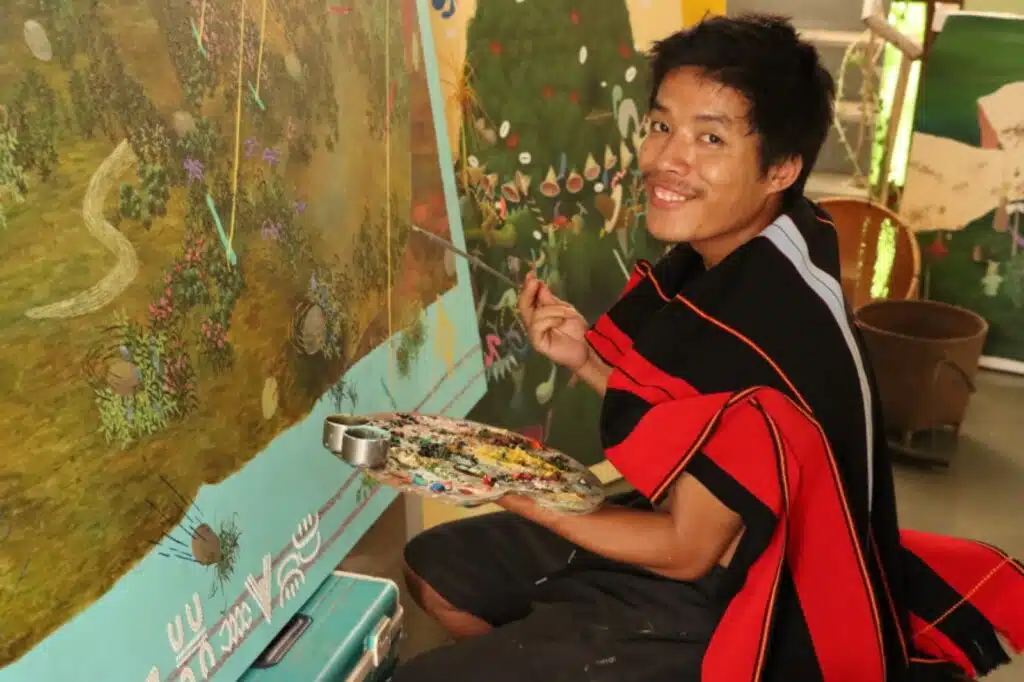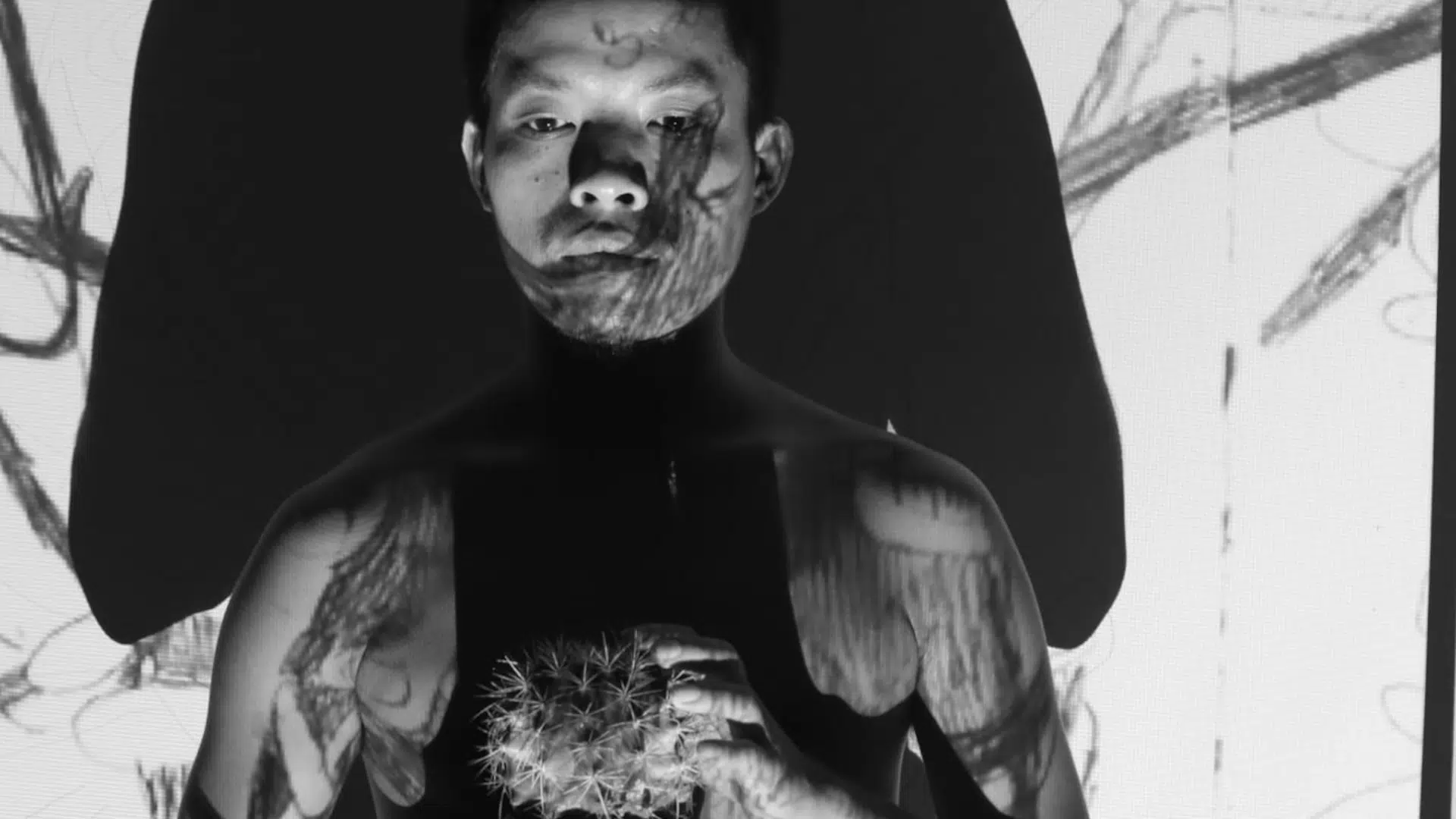Thamshangpha Maku, or as most know him, Merci, is an unassuming presence, with a large and varied body of work under his belt even as a young artist. Originally from Chandel, Manipur, the artist is now based in Baroda, Gujarat, close to his alma mater, the Maharaja Sayajirao University where he completed a Masters in Visual Art in 2022. “Back at home, when I was young, I would make portraits of friends when we hung out,” Merci says about his beginnings. “I did it without even thinking about it.” Now, after almost a decade of living away from home, it is all he thinks about, calling his relationship with art almost “sentimental”. His studio is full of studies on paper, experiments in bamboo weaving and poster boards over-flowing with ideas, representing various stages of the paintings, sculptures and performances that Merci has become well known for.
“We lived one step away from Myanmar”, Merci says, describing his early life growing up in a Naga tribal community in the hills of Manipur on the Eastern border of India. “When we were young, we thought we lived in paradise and spent our days swimming in the river, never worried about returning home.” With time, his memory of home has become fuller and more complicated. He continues, “but we were also always afraid; there was the constant threat of violence because of conflict and insurgency. Every house in the village had a safe house for when there were firings, and I remember hiding out with my mother in them, hearing bullets fly overhead.” Merci also remembers stories of trees full of the ghosts of army men and his father’s hobby of collecting war helmets, shells and other war paraphernalia — remnants of the Japanese invasion of the state during World War II and harbingers of the violence to come in the region.
“I take images, materials and performance ideas from my research into my practice. They act as a medium for me, as direct representations of who I am.”
“Home creates so much narrative and story for me,” the artist says, “and my art is about me as a person, my experiences and my home.” Deep research into Naga art practices such as basket weaving, textile making and performance, particularly those of the Maring community to which he belongs, grounds Merci’s open approach to art-making, not limited to any one medium. “Research into Naga art and culture, which I began during my Master’s dissertation, has played a big part in my creative process,” he shares. “I take images, materials and performance ideas from my research into my practice. They act as a medium for me, as direct representations of who I am.”
DOWNLOAD A SPECIAL ARTIST POSTER >
One such work is Merci’s interpretation of a karap — a traditional Naga bamboo meat smoking platform, hung over a flame to cook and preserve foods — as a self portrait. “I wanted to think about the idea of preservation of cultural memory and identity, and as I grow as an artist, I am becoming more and more interested in these abstract ways of thinking about ‘home’,” Merci explains. The bamboo smoker functions as a self portrait both in its direct reference to Naga tradition and as a visual metaphor for a tool for preservation, a memory keeper — Merci’s ambition as an artist. “I cut the bamboo myself, I make my paper myself, and these materials also become a part of my story,” he says. “Building all my work myself is my way of reclaiming my memories, my story, and in this way making a political statement.”
 The artist wrapped in a traditional Naga shawl in his Baroda studio. Courtesy of the artist.
The artist wrapped in a traditional Naga shawl in his Baroda studio. Courtesy of the artist.
When asked about how he wants his work to be understood, Merci says, “Actually, I am trying to show people that my life is also a part of theirs.” In a performance at HH Art Spaces in September 2023 for example, he created recipes from his childhood for the Goan audience, in the process unearthing memories of cooking with his brother and of his mother’s warnings to “eat fast because if there is an attack, you will die hungry and your soul will be starving.” In another performance in rural Bihar earlier in the year as part of a residency with the Foundation of Indian Contemporary Art (FICA), the artist devised a game in which he tied a rope around his waist, made using the local Sikki weaving technique, and around a wheel, and invited passersby to turn the wheel to tighten the knot around his waist in return for a few hundred rupees.
For Merci, art is a language with which he can discover and express his ever-shifting identity. “I carry my language,” he says, “And it finds its way into my home that is made and not given.” To this end, Merci is currently working on drawings and basket-weaves reflecting on the memories and losses suffered by the people of Manipur inspired by the poetry of Robin S Ngangom.
Thamsangpha ‘Merci’ Maku was born in 1999 in Chandel, Manipur. His work will be shown at India Art Fair 2024 as part of its Artists in Residence programme.


